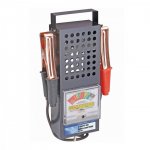I had a pair of these Absorbent Glass Mat (AGM) batteries lying about for a while as I could not get them to take a charge. In fact the battery charger would stop and not even attempt to charge the battery. I bought a new battery charger a while ago and didn't really pay much attention to all of the extras as I really had purchased it to charge the in-law's lawn mower battery. The other day I noticed it had a battery repair setting. I hsd read about this battery repair/recovery from a military memo (I don't think it was a tech memo. I will dig around and see if I can find it) and I think one of those comic book type memos last year so I thought ahaaa, hoping the repair mode of my $50 battery charger will actually work.
So I hooked up the charger to one of the batteries, pushed the repair button, and it went all night working in the repair mode. In the morning I charged it with the 10 amp setting. I then hooked the other battery up, set it to the repair mode, let it do its thing overnight, and then charged it to 100%. The batteries are now both showing about 13.4 volts. This is a huge improvement from not even being able to accept a charge.
I guess one way to check on how well this worked is to have a shop do a load test on them. I am pretty excited about this if I can recover these batteries. Has anyone else had any luck with this.
So I hooked up the charger to one of the batteries, pushed the repair button, and it went all night working in the repair mode. In the morning I charged it with the 10 amp setting. I then hooked the other battery up, set it to the repair mode, let it do its thing overnight, and then charged it to 100%. The batteries are now both showing about 13.4 volts. This is a huge improvement from not even being able to accept a charge.
I guess one way to check on how well this worked is to have a shop do a load test on them. I am pretty excited about this if I can recover these batteries. Has anyone else had any luck with this.
Attachments
-
2.2 MB Views: 50
-
2.4 MB Views: 56
-
2.1 MB Views: 59
-
2.6 MB Views: 54
-
2.6 MB Views: 40
Last edited:











